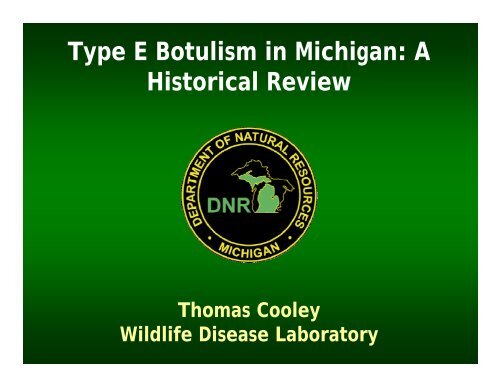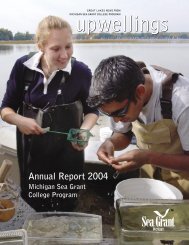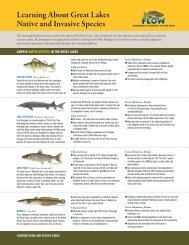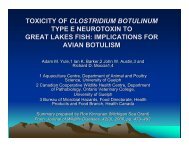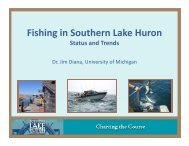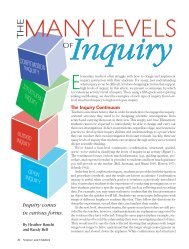Type E Botulism in Michigan - Michigan Sea Grant
Type E Botulism in Michigan - Michigan Sea Grant
Type E Botulism in Michigan - Michigan Sea Grant
You also want an ePaper? Increase the reach of your titles
YUMPU automatically turns print PDFs into web optimized ePapers that Google loves.
<strong>Type</strong> E <strong>Botulism</strong> <strong>in</strong> <strong>Michigan</strong>: A<br />
Historical Review<br />
Thomas Cooley<br />
Wildlife Disease Laboratory
In the Beg<strong>in</strong>n<strong>in</strong>g<br />
• The first waterfowl dieoff<br />
attributed to<br />
botulism <strong>in</strong> <strong>Michigan</strong><br />
occurred <strong>in</strong> 1941, be<strong>in</strong>g<br />
diagnosed <strong>in</strong> wild ducks<br />
<strong>in</strong> the Lake Erie marshes<br />
near Monroe. The tox<strong>in</strong><br />
was identified as <strong>Type</strong> C.<br />
• Approximately 1000<br />
ducks and shorebirds<br />
died.
In the Beg<strong>in</strong>n<strong>in</strong>g (cont.)<br />
• Scattered reports of dead gulls and 1 loon<br />
occurred <strong>in</strong> counties on Lake <strong>Michigan</strong>, Lake<br />
Huron, and Lake Superior between 1959 and<br />
1962.<br />
• No birds were exam<strong>in</strong>ed,<br />
so no cause of death<br />
was determ<strong>in</strong>ed.
1963<br />
• The first waterfowl die-off attributed to <strong>Type</strong><br />
E botulism tox<strong>in</strong> occurred <strong>in</strong> 1963.<br />
• Prior to this die-off <strong>Type</strong> E botulism was not<br />
known to exist <strong>in</strong> wild birds <strong>in</strong> North America.<br />
• The 1963 die-off extended from the Indiana<br />
border to Leelanau County, nearly the entire<br />
Lake <strong>Michigan</strong> shorel<strong>in</strong>e of the Lower<br />
Pen<strong>in</strong>sula.<br />
• The estimated mortality was 7720 birds (3300<br />
loons, 4290 gulls, and 130 miscellaneous<br />
birds).
1963 (cont.)<br />
• The die-off occurred between August and<br />
December.<br />
– Gulls <strong>in</strong> early August <strong>in</strong> Van Buren County.<br />
– Loons <strong>in</strong> mid-November <strong>in</strong> Berrien County.<br />
– Loons and Gulls <strong>in</strong> early December <strong>in</strong> Van Buren<br />
County.<br />
• The greatest mortality occurred <strong>in</strong> late<br />
November/early December.
<strong>Type</strong> E <strong>Botulism</strong> <strong>in</strong> <strong>Michigan</strong>, 1963
1964<br />
• The 1964 die-off occurred along the northern<br />
end of Lake <strong>Michigan</strong> from St. Ignace to<br />
Wiscons<strong>in</strong>.<br />
• The estimated mortality was 4920 birds (3570<br />
loons, 820 gulls, 200 grebes, 240 ducks, and 30<br />
miscellaneous birds).<br />
• The die-off occurred between August and<br />
October.<br />
– Gulls <strong>in</strong> early August <strong>in</strong> Delta County (Upper<br />
Pen<strong>in</strong>sula), and Benzie, Oceana, and north and<br />
south Manitou Islands (Lower Pen<strong>in</strong>sula).
1964 (cont.)<br />
– Loons <strong>in</strong> early September <strong>in</strong> Delta County.<br />
– Loons <strong>in</strong> late September/early October <strong>in</strong> Delta,<br />
Schoolcraft, and Mack<strong>in</strong>ac Counties.<br />
– Loons <strong>in</strong> early October <strong>in</strong> Leelanau County and on<br />
Beaver Island (Charlevoix County).<br />
• Compared to 1963 there were considerably<br />
fewer gulls but more grebes and ducks. Total<br />
loon numbers were comparable.
1964 (cont.)<br />
• Mortality was the<br />
heaviest <strong>in</strong> the north<br />
end of Lake <strong>Michigan</strong><br />
and peaked among<br />
loons <strong>in</strong> early<br />
October.<br />
• Several waves of loon<br />
carcasses were found<br />
over a 3 month<br />
period.<br />
Boll<strong>in</strong>ger
<strong>Type</strong> E <strong>Botulism</strong> <strong>in</strong> <strong>Michigan</strong>, 1964
1965<br />
• No estimates were determ<strong>in</strong>ed <strong>in</strong> the 1965<br />
die-off.<br />
• The mortality of loons was probably less than<br />
<strong>in</strong> 1963 and 1964.<br />
• Mortality was conf<strong>in</strong>ed largely to the northern<br />
end of Lake <strong>Michigan</strong> and primarily <strong>in</strong>volved<br />
loons and grebes. Dead gulls were more widely<br />
distributed.
• Heavy losses also<br />
occurred among gulls<br />
on Sag<strong>in</strong>aw Bay <strong>in</strong><br />
Lake Huron.<br />
1965 (cont.)
<strong>Type</strong> E <strong>Botulism</strong> <strong>in</strong> <strong>Michigan</strong>, 1965
1966<br />
• The 1966 die-off consisted of scattered losses<br />
of gulls along much of Lake <strong>Michigan</strong> with<br />
additional mortality consist<strong>in</strong>g of m<strong>in</strong>or loon<br />
losses and significant grebe losses.<br />
• Mortality was along the Upper Pen<strong>in</strong>sula<br />
shorel<strong>in</strong>e.<br />
• The die-off occurred <strong>in</strong> October.<br />
• Considerable mortality of gulls and some<br />
water birds <strong>in</strong> Sag<strong>in</strong>aw Bay <strong>in</strong> Lake Huron.
<strong>Type</strong> E <strong>Botulism</strong> <strong>in</strong> <strong>Michigan</strong>, 1966
1976<br />
• The 1976 die-off extended from the Indiana<br />
border to Muskegon.<br />
• The estimated mortality was 600-1000 birds.<br />
• The die-off occurred <strong>in</strong> October and<br />
November.<br />
• November 8, 1976 - A flight from the Indiana-<br />
<strong>Michigan</strong> border to Muskegon (145 km) found<br />
592 dead loons, 6 moribund loons, and 6 dead<br />
gulls.
1976 (cont.)<br />
• Between October 26 and November 19, 1976,<br />
342 avian carcasses were collected and<br />
exam<strong>in</strong>ed. The species exam<strong>in</strong>ed were 330<br />
common loons, 1 red-throated loon, 6 gulls, 1<br />
old squaw (long-tailed duck), 2 grebes (1<br />
eared grebe and 1 unidentified), 1 redhead,<br />
and 1 white-w<strong>in</strong>ged scoter.
<strong>Type</strong> E <strong>Botulism</strong> <strong>in</strong> <strong>Michigan</strong>, 1976
1981<br />
• The 1981 die-off occurred along the southern<br />
and eastern end of Lake Superior at Whitefish<br />
Po<strong>in</strong>t <strong>in</strong> Chippewa County.<br />
• 13 birds were exam<strong>in</strong>ed and <strong>Type</strong> E botulism<br />
was confirmed.
<strong>Type</strong> E <strong>Botulism</strong> <strong>in</strong> <strong>Michigan</strong>, 1981
1983<br />
• The 1983 die-off occurred along the northern<br />
end of Lake <strong>Michigan</strong> <strong>in</strong> Delta and Schoolcraft<br />
Counties <strong>in</strong> the Upper Pen<strong>in</strong>sula.<br />
• The estimated mortality was 592 common<br />
loons.<br />
Timmermans
1983<br />
• It was suspected that the loons dy<strong>in</strong>g dur<strong>in</strong>g<br />
this outbreak were from large rafts of birds<br />
reported by the <strong>Michigan</strong> Department of<br />
Natural Resources to be offshore and to the<br />
southeast of the Garden Pen<strong>in</strong>sula.
<strong>Type</strong> E <strong>Botulism</strong> <strong>in</strong> <strong>Michigan</strong>, 1983
Source of the Clostridium<br />
botul<strong>in</strong>um <strong>Type</strong> E Organism<br />
• Spores of C. botul<strong>in</strong>um type E are widely<br />
distributed <strong>in</strong> bottom sediments and <strong>in</strong> the<br />
alimentary tracts of fish from the Great Lakes.<br />
Because of this it is apparent that a potential<br />
exists for development of tox<strong>in</strong>.<br />
• The organism is found <strong>in</strong> the bottom sediments<br />
of the Pacific and Atlantic Oceans.<br />
• Serious effects are derived from the<br />
consumption of the tox<strong>in</strong> that is produced as<br />
the bacteria grows.
Source of the Clostridium<br />
botul<strong>in</strong>um <strong>Type</strong> E Organism (cont.)<br />
• Possibly the carcasses of dead fish provide a<br />
good medium for growth and tox<strong>in</strong> production.
Consumption of the Bacteria<br />
• <strong>Type</strong> E botulism affects primarily <strong>in</strong>habitants<br />
of the open lake and bare beaches, namely<br />
gulls, loons, grebes, and mergansers. All of<br />
which are fish eaters.<br />
• Fish rema<strong>in</strong>s have<br />
consistently been<br />
found <strong>in</strong> dead birds<br />
(80-100% of the<br />
affected birds<br />
exam<strong>in</strong>ed).
Gulls<br />
• The gulls that died dur<strong>in</strong>g the 1963 through<br />
1966 die-offs likely were <strong>in</strong>fected by<br />
consum<strong>in</strong>g dead fish, particularly alewives,<br />
which accumulated <strong>in</strong> considerable quantities<br />
<strong>in</strong> the water and on the beach.<br />
• The alewife had become the predom<strong>in</strong>ant fish<br />
<strong>in</strong> Lake <strong>Michigan</strong>. The alewife, an <strong>in</strong>vader from<br />
the Atlantic Ocean was estimated to<br />
constitute 95%, by weight, of the fish <strong>in</strong> Lake<br />
<strong>Michigan</strong>.
Gulls (cont.)<br />
• The first record of<br />
alewives <strong>in</strong> Lake <strong>Michigan</strong><br />
was <strong>in</strong> 1949 and they<br />
were considered rare<br />
until the mid 1950’s.<br />
• The unusual<br />
characteristic of this fish<br />
species was they died en<br />
mass annually.
Loons, Grebes, and Mergansers<br />
• The means by which they <strong>in</strong>gest the bacteria<br />
and tox<strong>in</strong> was <strong>in</strong> question s<strong>in</strong>ce they do not<br />
eat dead fish. They may mistake fish carcasses<br />
<strong>in</strong> the water for live fish<br />
or fish eaten by the<br />
species may have<br />
become moribund from<br />
the botulism tox<strong>in</strong>.<br />
Wills
Food Habit Studies for the 1963<br />
• In Gulls:<br />
and 1964 Die-offs<br />
– 28 birds studied<br />
– Alewives and yellow perch<br />
composed 82% of the food<br />
items present.<br />
• In Loons:<br />
– 149 birds studied<br />
– Alewives and smelt composed 85% of the food<br />
items present.<br />
Record-Eagle
Cl<strong>in</strong>ical Signs of <strong>Type</strong> E <strong>Botulism</strong><br />
• <strong>Botulism</strong> tox<strong>in</strong>s exert their primary action on<br />
nerve end<strong>in</strong>gs and prevent the transmission of<br />
nerve impulses to the muscles (flaccid<br />
paralysis).<br />
• Loss of muscle (motor) control of the w<strong>in</strong>gs,<br />
legs, neck, and then the rema<strong>in</strong>der of the<br />
body.<br />
• W<strong>in</strong>gs hang<strong>in</strong>g at their sides.<br />
• Head erect <strong>in</strong> some birds, others are too weak<br />
to hold head erect.
Cl<strong>in</strong>ical Signs of <strong>Type</strong> E <strong>Botulism</strong><br />
(cont.)<br />
• Eyes are closed, the<br />
nictat<strong>in</strong>g membrane<br />
becomes paralyzed.<br />
• Labored breath<strong>in</strong>g and<br />
eventual respiratory<br />
failure.<br />
• Retention of<br />
consciousness.<br />
• Legs are extended to<br />
the rear.<br />
Bourque
Pathology<br />
• No lesions observed except wet frothy lungs<br />
which suggests drown<strong>in</strong>g.<br />
• Birds are generally <strong>in</strong> good to excellent<br />
physical condition.<br />
• No evidence of significant toxicological levels –<br />
either metals or pesticides.
<strong>Sea</strong>sonality/Carcass-Maggot Cycle<br />
• Gull die-offs <strong>in</strong> July and August<br />
• Loons, grebes, and merganser die-offs <strong>in</strong> late<br />
September and October.<br />
• Loon and Gull die-offs <strong>in</strong> late November/early<br />
December.<br />
• <strong>Type</strong> E botulism generally occurs <strong>in</strong> cool fall<br />
weather when fly <strong>in</strong>festation of carcasses is<br />
less likely.
<strong>Sea</strong>sonality/Carcass-Maggot Cycle<br />
(cont.)<br />
• Healthy loons usually raft offshore <strong>in</strong> the fall<br />
and are not likely to be exposed to carcasses<br />
along the shore or to consume maggots or<br />
other <strong>in</strong>vertebrates associated with carcasses.<br />
• Most loons died on the open lake and drifted<br />
some distance <strong>in</strong> the w<strong>in</strong>d and water currents<br />
before wash<strong>in</strong>g up on shore.<br />
• Gulls died <strong>in</strong> the water as well as on the<br />
beach.
Significant F<strong>in</strong>d<strong>in</strong>gs from the Dieoffs<br />
• “The most significant f<strong>in</strong>d<strong>in</strong>g to date is the<br />
presence of the tox<strong>in</strong> of <strong>Type</strong> E Clostridium<br />
botul<strong>in</strong>um, causative agent of botulism, <strong>in</strong> the<br />
blood of dead loons and gulls.”<br />
• “A most significant f<strong>in</strong>d<strong>in</strong>g was the occurrence<br />
of tox<strong>in</strong> of C. botul<strong>in</strong>um type E <strong>in</strong> the tissues<br />
of a majority of the birds.”
Significant F<strong>in</strong>d<strong>in</strong>gs from the Dieoffs<br />
(cont.)<br />
• “I wonder if there is a significance <strong>in</strong> the fact or only<br />
co<strong>in</strong>cidental, that the problem of <strong>Type</strong> E botulism <strong>in</strong><br />
the region has become apparent only s<strong>in</strong>ce the<br />
advent of high populations of alewife <strong>in</strong> the upper<br />
Great Lakes.”<br />
• “While the vulnerability of gulls, loons, and other<br />
water birds to the tox<strong>in</strong> has not yet been fully<br />
demonstrated, we believe that accumulated<br />
evidence po<strong>in</strong>ts strongly to botulism caused by the<br />
tox<strong>in</strong> of C. botul<strong>in</strong>um type E as the cause for recent<br />
Lake <strong>Michigan</strong> bird mortalities.”
Significant F<strong>in</strong>d<strong>in</strong>gs from the Dieoffs<br />
(cont.)<br />
• “Evidence suggests that botulism <strong>Type</strong> E <strong>in</strong><br />
gulls and loons is acquired through <strong>in</strong>gestion of<br />
fish conta<strong>in</strong><strong>in</strong>g the tox<strong>in</strong>.”<br />
• “The sporadic reports of epizootics of <strong>Type</strong> E<br />
botulism suggests that factors determ<strong>in</strong><strong>in</strong>g<br />
tox<strong>in</strong> production or its availability to birds<br />
vary from year to year.”
Questions?


